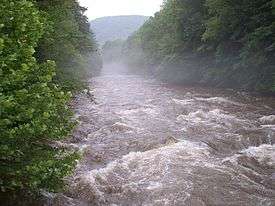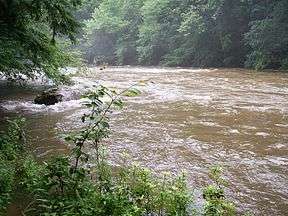Cranberry River (West Virginia)
The Cranberry River is a tributary of the Gauley River located in southeastern West Virginia in the United States.[4] It is a part of the Mississippi River watershed, by way of the Gauley, Kanawha, and Ohio Rivers, draining an area of 74 square miles (192 km2).[2]
| Cranberry River | |
|---|---|
 High water near Big Rock Campground in Monongahela National Forest | |
| Location | |
| Country | United States |
| State | West Virginia |
| Counties | Pocahontas, Webster, Nicholas |
| Physical characteristics | |
| Source | South Fork Cranberry River |
| • location | Cranberry Mountain, Pocahontas County, WV |
| • coordinates | 38°12′48″N 80°13′14″W |
| • elevation | 3,890 ft (1,190 m) |
| 2nd source | North Fork Cranberry River |
| • location | Black Mountain, Pocahontas County, WV |
| • coordinates | 38°14′03″N 80°14′32″W |
| • elevation | 4,364 ft (1,330 m) |
| Source confluence | |
| • location | Pocahontas County, WV |
| • coordinates | 38°15′28″N 80°19′27″W |
| • elevation | 3,176 ft (968 m) |
| Mouth | Gauley River[1] |
• location | Woodbine, WV |
• coordinates | 38°17′58″N 80°36′49″W |
• elevation | 1,919 ft (585 m) |
| Length | 24 mi (39 km)[1] |
| Basin size | 74 sq mi (190 km2)[2] |
| Discharge | |
| • location | near Richwood, WV[3] |
| • average | 317 cu ft/s (9.0 m3/s)[3] |
| • minimum | 50 cu ft/s (1.4 m3/s)(1986) |
| • maximum | 3,450 cu ft/s (98 m3/s)(1970) |

The river has also been known historically as Cranberry Creek.[1] The river was named for cranberry bogs along its course.[5]
Geography
The Cranberry River is formed in southwestern Pocahontas County by the confluence of its North and South forks.[1] The South Fork, the longer of the two at a length of 9 miles (14 km),[6] rises on Cranberry Mountain just west of the Highland Scenic Highway before flowing through the Cranberry Glades Botanical Area. The North Fork rises about 2 miles (3.2 km) north on Black Mountain.
Below the confluence of its forks, the Cranberry flows for 24 miles (39 km) generally westward towards its mouth at the Gauley River near Craigsville.
Since the river flows mostly through United States Forest Service land, no more than a handful of people live along its banks; the few that do reside near the mouth of the river. However, the Cranberry River has several pay campgrounds, free campsites, and picnic areas along its banks.[7]
Fishing
The Cranberry River and its small tributaries are regarded as some of the finest trout streams in the eastern United States. Until recently, however, trout fishing on the south fork was limited to the lower half of the river due to acid rain. The West Virginia Division of Natural Resources has worked to counter this problem by installing a liming station on the north fork of the river.[8]
See also
- List of West Virginia rivers
External links
References
- "Cranberry River". Geographic Names Information System. United States Geological Survey. Retrieved 2008-12-30.
- Grafton, Emily. 2006. "Cranberry River." The West Virginia Encyclopedia. Ken Sullivan, editor. Charleston, WV: West Virginia Humanities Council. ISBN 0-9778498-0-5.
- "USGS 03187500 CRANBERRY RIVER NEAR RICHWOOD, WV". National Water Information System. U.S. Geological Survey. Archived from the original on 2013-10-17. Retrieved 2008-12-30.
- DeLorme (1997). West Virginia Atlas & Gazetteer. Yarmouth, Maine: DeLorme. ISBN 0-89933-246-3.
- Kenny, Hamill (1945). West Virginia Place Names: Their Origin and Meaning, Including the Nomenclature of the Streams and Mountains. Piedmont, WV: The Place Name Press. p. 189.
- "South Fork Cranberry River". Geographic Names Information System. United States Geological Survey. Retrieved 2008-12-30.
- Big Rock Campground, Cranberry Campground, Cranberry River campsites, Woodbine Picnic Area, in the Monongahela National Forest
- Gasper, Donald C. New Native Brook Trout Streams, A New Wilderness (pdf)